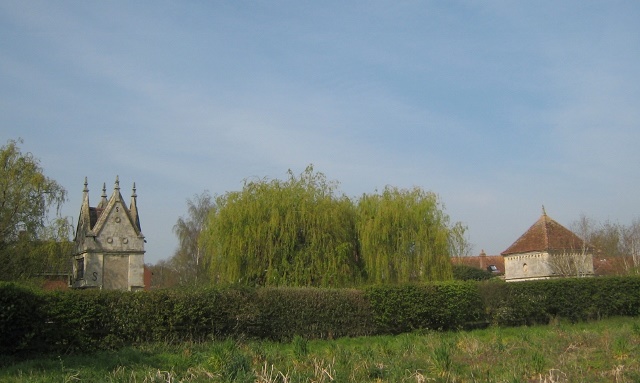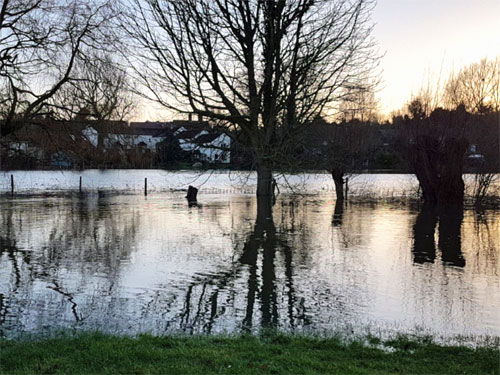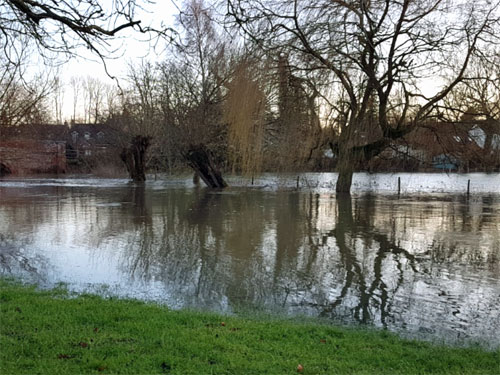History Alphabet

covers the myriad of Findings of an archaeological nature within the Village boundaries. A flint fossil found at Glenlodge Farm in 1983, was declared by the British Museum to have existed 100 million years before man - but had arrived in Bawburgh by glacial drift. More "up to date", in 1941, Bronze Age pottery was found, again on the same farmland, during ploughing. The area is now a Golf Course. There are actually 76 archaeological finds or sites in the Parish of Bawburgh lodged at the Norfolk Landscape Archaeology Unit, but some of these are present-day listed Sites, but also many Roman finds - including a Roman Cremation Cemetery, which was the subject of "digs" in 1949 and 1971. The Castle Museum at Norwich, looks after those findings.
F is also for the Rev. Thomas Albert Frost
See V is for the Vicars of BawburghVicar of Bawburgh between 1938 and 1948
F is also for the Follies (The Garden House and Hermits House)
 Variously described as a dovecote and slipper chapel, the two follies now
residing in the gardens of Numbers 5 and 7 Hall Farm Place, were originally
garden follies in the grounds of Bawburgh Hall. The Hall was demolished in
1963 and the follies allowed to stand, as long as the development which took
place around them in 1980, allowed for access for the public (by
arrangement).
Variously described as a dovecote and slipper chapel, the two follies now
residing in the gardens of Numbers 5 and 7 Hall Farm Place, were originally
garden follies in the grounds of Bawburgh Hall. The Hall was demolished in
1963 and the follies allowed to stand, as long as the development which took
place around them in 1980, allowed for access for the public (by
arrangement).
These iconic buildings have certainly been shrouded in mystery over the years, their date much debated. The question is whether they were built at the same time as The Hall (1634), or were later additions using old materials. The consensus following the advice of Gressenhall records (The Slipper House is number 9301 on their Sites and Monuments Records) and expert on landscape history, Tom Williamson of the UEA, is that they are late 16th or early 17th century garden buildings built of stone looted from some medieval structure—the dissolved chapel of Saint Walstan “perhaps”. Having established date, the naming continues to confuse. South Norfolk’s List of Buildings of Special Architectural or Historical Interest declares that the Garden House is at number 5 and was formerly a dovecote (actually the Hermits House is at number 5) and the Slipper Chapel, now Garden House is at number 7. We can safely assume the numbers have been switched, and that the Dovecote is now the Garden House, since archive photos show the dove openings where there are now windows. Mysterious and confusing perhaps, but iconic definitely!!
In September 2015, on the Open Heritage Days, the Hermitage and Slipper Chapel or Dovecote were opened to the public. Stephen Heywood, Historic Buildings Officer, conducted a very interesting tour of the two structures (he calls their colourful names "fanciful!"), explaining that they had been built from the stone from St Walstan's shrine at the church. Both houses were open to the public to celebrate the Heritage Days, and the group marvelled at how they might have been used to take "dessert" - the meaning of banquet, as opposed to a large meal! They seem quite small for this purpose.
Wikipedia says "In large meals a banqueting house was most likely to be used for eating dessert, if reasonably close to the main house. Otherwise it might be used on fine days for taking tea, or any kind of drink, snack or meal."
There is no sign today that the Slipper House was a dovecote, but there are photographs to prove this (see photo). So, as always, history is being re-written as we speak - it is now B is for Banqueting Houses, and not D is for Dovecote, in the ABC of Bawburgh!
F is also for the Flooding
 During January 2018 the river running through the village broke its banks
and flooded the fields. Although this is now a regular occurrence, the
heights reached by the river caused some concerns. On at least one day, the
water rose so high it covered part of the road on Stocks Hill above the
bridge. Several local residents told Bawburgh News they were worried the
river would flood their houses. However, the water receded and no property
was damaged.
During January 2018 the river running through the village broke its banks
and flooded the fields. Although this is now a regular occurrence, the
heights reached by the river caused some concerns. On at least one day, the
water rose so high it covered part of the road on Stocks Hill above the
bridge. Several local residents told Bawburgh News they were worried the
river would flood their houses. However, the water receded and no property
was damaged.
In February 1994, Neil Adgar, then a Senior Researcher in the School of Environmental Sciences at the University of East Anglia and Bawburgh resident, wrote a piece for the Bawburgh News in response to some local flooding. At the time of writing, 'global warming' was a relatively new term, only used for the first time in 1975 by geochemist Wallace Broecker. By 1994, some of the world had started to listen to the scientific concerns and some countries were starting to put policies in place. Most of us still had no idea how this issue would affect us 24 years on. Sixteen of the seventeen warmest years on record are now between 2001 and 2016.....This is the article in full.
Are the Bawburgh floods the result of global warming? The Bawburgh News reported that the floods on 14 October were the highest in 12 years and yet there have been four major floods in the past three months. The obvious cause of these is the wet autumn, following a wet summer, following a wet winter last year: before that we had three years of drought. Is this a sign of global warming and more frequent floods to come?
 Global warming is the name given to the rising temperature of the earth
brought about by the changing composition of the atmosphere and hence
trapping more of the sun's heat. The changes in the composition of the
atmosphere come about primarily because of our burning coal, oil and gas in
activities such as transport generating electricity. There is growing
consensus among scientists that global warming is occurring: the hottest
year for the whole earth since temperature records began 150 years ago was
1990; the second hottest year on record was 1991 and the subsequent are
probably only cooler because of volcanic eruptions sending dust into the
upper atmosphere and having a cooling effect. The reality of global warming
is that the weather is going to become less predictable as the average
temperature and rainfall change. Extreme events such as prolonged droughts,
storms and floods will become more common, over the timescale of the next
century. Unfortunately, however, it is very difficult to link individual
events to global warming, whether they are floods in the Rhine Valley, the
Mississippi, or even in Bangladesh, all of which occurred in 1993.
Global warming is the name given to the rising temperature of the earth
brought about by the changing composition of the atmosphere and hence
trapping more of the sun's heat. The changes in the composition of the
atmosphere come about primarily because of our burning coal, oil and gas in
activities such as transport generating electricity. There is growing
consensus among scientists that global warming is occurring: the hottest
year for the whole earth since temperature records began 150 years ago was
1990; the second hottest year on record was 1991 and the subsequent are
probably only cooler because of volcanic eruptions sending dust into the
upper atmosphere and having a cooling effect. The reality of global warming
is that the weather is going to become less predictable as the average
temperature and rainfall change. Extreme events such as prolonged droughts,
storms and floods will become more common, over the timescale of the next
century. Unfortunately, however, it is very difficult to link individual
events to global warming, whether they are floods in the Rhine Valley, the
Mississippi, or even in Bangladesh, all of which occurred in 1993.
There may also, of course, be other causes of the floods in Bawburgh such as changes in the course of the Yare over the years. Having only lived in Bawburgh for 2 years, I have no great knowledge to base my opinions on: maybe the bridge over the bypass or other work up or downstream may be part of the cause. If the village has records of floods over the past centuries, these would be fascinating to look at and present and future records could be one role of the Bawburgh News itself.
So if global warming is a certainty, we must not be complacent and ignore the problem. Many other areas of the world will experience consequences more catastrophic than the Bawburgh floods. More countries do not have the resources to cope: one need only think of the consequences of flooding in Bangladesh or drought in Africa, or even the fate of low lying islands like the Maldives where sea level rise threatens the whole nation. The best strategy for Bawburgh and the world is to avoid global warming primarily by reducing our consumption of energy. There are many good reasons for conserving our stocks of coal, oil and gas, not least because of its direct link to global warming.
Neil Adgar is now Professor of Human Geography at the University of Exeter.
Return to History Alphabet